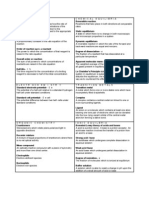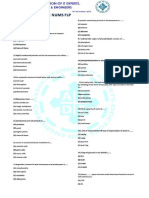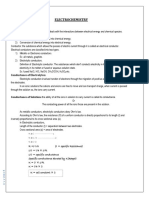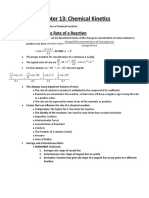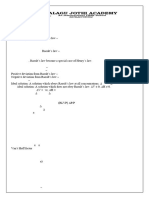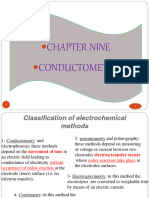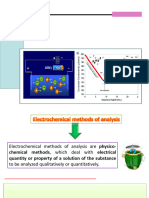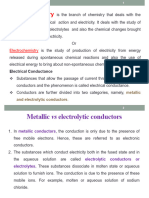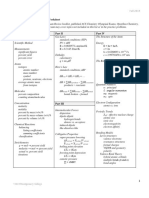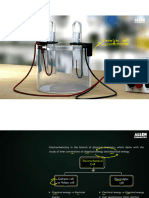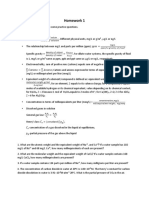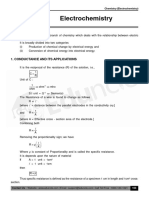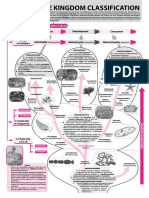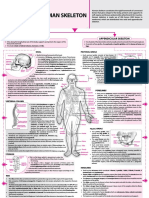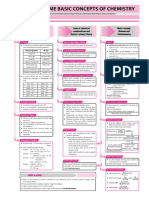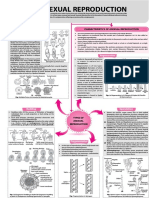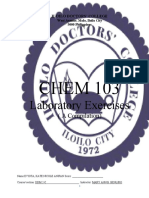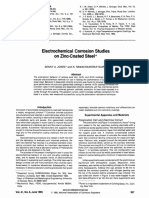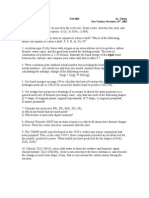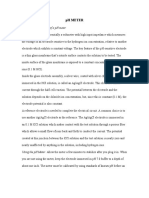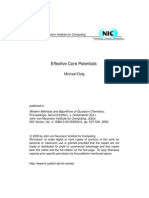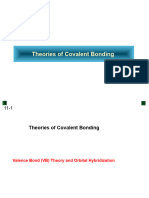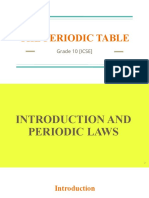0 ratings0% found this document useful (0 votes)
51 viewsChemistry - July 2015
Chemistry - July 2015
Uploaded by
Rahique ShuaibThis document provides an overview of physical chemistry concepts related to solutions, electrochemistry, and chemical kinetics. It defines key terms like concentration, conductivity, electrode potential, and rate of reaction. Laws and concepts covered include Henry's law, Raoult's law, Faraday's laws, the Nernst equation, and the Arrhenius equation. Solution types are defined as ideal, non-ideal, and azeotropes. Colligative properties and their dependence on solute particles are also summarized.
Copyright:
© All Rights Reserved
Available Formats
Download as PDF, TXT or read online from Scribd
Chemistry - July 2015
Chemistry - July 2015
Uploaded by
Rahique Shuaib0 ratings0% found this document useful (0 votes)
51 views1 pageThis document provides an overview of physical chemistry concepts related to solutions, electrochemistry, and chemical kinetics. It defines key terms like concentration, conductivity, electrode potential, and rate of reaction. Laws and concepts covered include Henry's law, Raoult's law, Faraday's laws, the Nernst equation, and the Arrhenius equation. Solution types are defined as ideal, non-ideal, and azeotropes. Colligative properties and their dependence on solute particles are also summarized.
Original Description:
Infographic
Copyright
© © All Rights Reserved
Available Formats
PDF, TXT or read online from Scribd
Share this document
Did you find this document useful?
Is this content inappropriate?
This document provides an overview of physical chemistry concepts related to solutions, electrochemistry, and chemical kinetics. It defines key terms like concentration, conductivity, electrode potential, and rate of reaction. Laws and concepts covered include Henry's law, Raoult's law, Faraday's laws, the Nernst equation, and the Arrhenius equation. Solution types are defined as ideal, non-ideal, and azeotropes. Colligative properties and their dependence on solute particles are also summarized.
Copyright:
© All Rights Reserved
Available Formats
Download as PDF, TXT or read online from Scribd
Download as pdf or txt
0 ratings0% found this document useful (0 votes)
51 views1 pageChemistry - July 2015
Chemistry - July 2015
Uploaded by
Rahique ShuaibThis document provides an overview of physical chemistry concepts related to solutions, electrochemistry, and chemical kinetics. It defines key terms like concentration, conductivity, electrode potential, and rate of reaction. Laws and concepts covered include Henry's law, Raoult's law, Faraday's laws, the Nernst equation, and the Arrhenius equation. Solution types are defined as ideal, non-ideal, and azeotropes. Colligative properties and their dependence on solute particles are also summarized.
Copyright:
© All Rights Reserved
Available Formats
Download as PDF, TXT or read online from Scribd
Download as pdf or txt
You are on page 1of 1
CONCEPT PHYSICAL CHEMISTRY (Part-I)
Solutions, Electrochemistry and Chemical Kinetics form the basis of physical chemistry and give an idea about the nature of
solutions, relationship between chemical energy and electrical energy in redox reactions and also the rates of reactions.
SOLUTIONS ELECTROCHEMISTRY CHEMICAL KINETICS
Expressing Concentration of Solutions Basic Terms Rate of Reaction
Mass percentage : Grams of solute in 100 g of Conductance : Reciprocal of resistance. For a reaction, aA + bB xX + yY
solution. 1 1 d[ A] 1 d[ B] 1 d[ X ] 1 d[Y ]
Strength : Grams of solute in 1 L of solution. C ; Unit : 1 or S Rate
R a dt b dt x dt y dt
Molarity : Moles of solute in 1 L of solution. Conductivity : Conductance of 1 cm3 of the Greater the concentration of reactants, faster is the
Normality : Gram equivalents of solute in 1 L reaction.
conductor.
of solution. Rate becomes double for every 10° rise in
l
Molality : Moles of solute in 1 kg of solvent. C ; Unit : 1 cm 1 or S cm 1 temperature.
Mole fraction : Moles of the component/ total a
Greater the surface area of reactants, faster is the
Equivalent conductivity : Conductance of a
no. of moles of all components. reaction.
Parts per million : Mass of solute in one solution containing 1 g-equivalent of an
million (106) parts by mass of solution. electrolyte dissolved in V cm3 of the solution.
1000 Order and Molecularity
eq ; Unit : S cm2 eq 1
Laws Normality
Molar conductivity : Conductance of a solution For a rate law equation, rate = k[A]a[B]b
Henry’s law : m = Kp or p = KHx Order of reaction = a + b.
containing 1 mole of an electrolyte dissolved in Molecularity is the number of atoms, ions or
where KH is Henry’s constant having units of V cm3 of the solution. molecules that must collide simultaneously with
pressure.
1000 one another to result into a chemical reaction.
Raoult’s law :
p ps n2 m ; Unit : S cm2 mol 1
For non-volatile solute : x2 Molarity
p n1 n2 Electrode potential : Tendency of an electrode to
For volatile components : lose or gain electrons when it is in contact with Integrated Rate Equation and Half-Life
pA = xAp°A ; pB = xB pB° and ptotal = pA + pB
solution of its own ions.
Cell potential or EMF of the cell : The difference Order Integrated Half-life
rate equation t1/2 =
Types of Solutions between electrode potentials of two half-cells.
0 [A]t = –kt + [A]0 [A]0/2k
Ideal solutions : A–B interactions are of same
magnitude as A–A and B–B interactions, Types of Cells 1 ln[A]t = –kt + ln[A]0 0.693/k
Vmix = 0 and Hmix = 0. 2 1/[A]t = kt + 1/[A]0 1/k [A]0
Non-ideal solutions : A–B interactions are of Electrochemical cell : Device used to convert
different magnitude than A–A and B–B chemical energy of a redox reaction into 1 [ B] [ A]
2 kt ln 0 –
interactions, Vmix 0 and Hmix 0. electrical energy. [ A]0 [ B]0 [ A]0[ B]
– Non - i d e a l s oluti ons show ing +ve Electrolytic cell : Device which uses electricity
1 1 2n 1 1
deviations : A–B interactions are weaker to bring about a non-spontaneous redox n (n 1) kt
than A–A and B–B interactions, Vmix reaction. [ A]n 1 [ A0 ]n 1 k (n 1)[ A]n0 1
= +ve, Hmix = +ve and resulting vapour
Relationship between time for different fractions of
pressure is higher than that expected.
Laws a first order reaction to complete,
– Non - i d e a l s oluti on s show i ng –ve
t3/4 or t75% = 2t1/2
deviations : A–B interactions are stronger
Faraday’s first law : W = Zit 3
than A–A and B–B interactions, Vmix = t 87.5% 3t1/2 t 75%
W1 E1 2
–ve, Hmix = –ve and resulting vapour Faraday’s second law : t93.75% = 4t1/2 = 2t75%
pressure is lower than that expected. W2 E2
t96.87% = 5t1/2
Azeotropes: Constant boiling mixtures. Kohlrausch’s law : For an electrolyte AxBy,
t99.9% = 10t1/2
°m = x°+ + y°– or °eq = °+ + °–
Colligative Properties
Temperature Dependence of Rate of
Colligative properties depend only on the Nernst Equation and Electrochemical Series Reaction and Effect of Catalyst
number of particles of solute dissolved in a
definite amount of solvent. These are : Nernst equation : For the reaction :
n+ –
Arrhenius equation : k = Ae–Ea/RT
– Elevation in boiling point : Boiling point M + ne M, Ea T2 T1
k
of solution is higher than that of pure or log 2
k1 2.303R T1T2
RT M
E E ln or
solvent. Tb = Tb – Tb° = Kb m nF [ M n ]
Activation energy
– Depression in freezing point : Freezing
point of solution is lower than that of pure 0.0591 1 = Threshold energy – Average kinetic
E E log n at 298 K
solvent. Tf = T°f – Tf = Kf m n [M ] energy of reactants
– Relative lowering of vapour pressure : For concentration cell : Collision theory : k = PZe–Ea/RT
p ps n 0.0591 C where P is steric factor and Z is collision
x2 2 (for dilute solutions, Ecell log 2 ; Ecell +ve if C2 C1
p n1 n <<< n ) n C1
frequency.
2 1
Catalyst increases the rate of a reaction
p ps n2 for dilute as well as For a reaction in equilibrium :
without itself undergoing any permanent chemical
ps n1 concentrated solutions 0.0591
E cell log K at 298 K change.
– Osmotic pressure : = CRT n
Electrochemical series : It is the arrangement of
electrodes in order of increasing standard
van’t Hoff Factor (i) and its Significance reduction potentials.
– This series helps in comparing the relative
HAVE A LOOK !
Observed value of colligative property
i oxidizing or reducing powers, relative Different solutions having same vapour pressure
Normal value of colligative property
activities of metals and to predict spontaneity are called isopiestic solutions.
Calculated molecular mass
of the redox reaction.
Observed molecular mass Deliquescent substances absorb moisture because
vapour pressure of their saturated solutions is less
For solute undergoing association :
n than that of water vapours in air at that
(1 i) ; i 1 Commercial Cells/Batteries temperature.
(Degree of association) n 1
For solute undergoing dissociation : Primary cells cannot be recharged e.g., dry cell, Efflorescent substances lose their water of
i 1 mercury cell. crystallisation because their hydrated crystals have
; i 1 vapour pressure larger than that of water vapours in
(Degree of dissociation) n 1 Secondary cells can be recharged e.g., lead air.
Modified colligative properties : storage battery, Ni–Cd storage cell.
p ps Association generally occurs in non-aqueous
Fuel cells convert the energy produced during
ix2 ; T = iK m, T = iK m; solvents (non-polar) because high dielectric
p b b f f combustion of fuels into electrical energy constant of water helps in the dissociation of the
= iCRT directly e.g., H2–O2 fuel cell. associated molecules.
You might also like
- CBSE Class 12 Chemistry - Important Formulas All Chapters PDFDocument6 pagesCBSE Class 12 Chemistry - Important Formulas All Chapters PDFjagannivas72% (79)
- Phys Chem 3 - ElectrochemistryDocument26 pagesPhys Chem 3 - ElectrochemistryClement ThabangNo ratings yet
- Chemistry DefinitionsDocument3 pagesChemistry DefinitionscesgemsNo ratings yet
- Nums FLPDocument27 pagesNums FLPRahique ShuaibNo ratings yet
- Revision NotesDocument5 pagesRevision NotesnainasjayanNo ratings yet
- Wbjee 12Document82 pagesWbjee 12akash.c.2005No ratings yet
- CHEMISTRY-XII _ AT A GLANCEDocument15 pagesCHEMISTRY-XII _ AT A GLANCEleviackermanop1991No ratings yet
- Unit1 ElectrochemistryDocument18 pagesUnit1 ElectrochemistryRajeshNo ratings yet
- Wa0025.Document7 pagesWa0025.Uday BhaskarNo ratings yet
- Chemistry XII Chp 2Document3 pagesChemistry XII Chp 2dhag2402No ratings yet
- Process RatesDocument45 pagesProcess RatesppaassssttiimmeeNo ratings yet
- FormulaDocument5 pagesFormuladebu3179No ratings yet
- Capsule For Low AchieversDocument17 pagesCapsule For Low AchieversdharunaswindNo ratings yet
- Complete Physical Chemistry Formula Revision-5 AprilDocument249 pagesComplete Physical Chemistry Formula Revision-5 AprildivyatewariapNo ratings yet
- Conductance 1st & 2nd LectureDocument18 pagesConductance 1st & 2nd Lectureleconmcharris2004No ratings yet
- Wa0001.Document17 pagesWa0001.hjsjjharishNo ratings yet
- 21 Chemical Kinetics Formula Sheets QuizrrDocument6 pages21 Chemical Kinetics Formula Sheets Quizrravyabansal2703No ratings yet
- CH13 Chemical KineticsDocument5 pagesCH13 Chemical KineticsCarlos Mella-RijoNo ratings yet
- 21 Chemical Kinetics Formula Sheets Getmarks AppDocument7 pages21 Chemical Kinetics Formula Sheets Getmarks Appmokshprajapati2541No ratings yet
- Conductometry 2023 - BPDocument40 pagesConductometry 2023 - BPfojirof555No ratings yet
- Chemistry 2Document17 pagesChemistry 2Harshit ChoudharyNo ratings yet
- 12 Chem. N Ch. 2Document2 pages12 Chem. N Ch. 2Mohammed IliasNo ratings yet
- Capsule for Low Achievers_240125_121555Document17 pagesCapsule for Low Achievers_240125_121555dewangan.gezika.zNo ratings yet
- Capsule For Low AchieversDocument17 pagesCapsule For Low AchieversPratham Zala100% (3)
- XII CHE MINIMUM MATERIALDocument6 pagesXII CHE MINIMUM MATERIALkalaip2007No ratings yet
- Study Material Chemistry 2022-23Document166 pagesStudy Material Chemistry 2022-23Akash Kumar UpadhyayNo ratings yet
- Wa0245 1Document45 pagesWa0245 1lm7032478No ratings yet
- Chemical Kinetics Class 12Document137 pagesChemical Kinetics Class 12Liyutsa ZirangeNo ratings yet
- Chemistry Class 12 Revision MaterialDocument52 pagesChemistry Class 12 Revision Materialkrish dabhi50% (2)
- Kinetics: - Collision Theory - Transition Theory - Consecutive and ParallelDocument16 pagesKinetics: - Collision Theory - Transition Theory - Consecutive and ParallelBharat SinghNo ratings yet
- Chemistry of Solutions-2021Document49 pagesChemistry of Solutions-2021Tiago PhillipeNo ratings yet
- Electrochemistry Short Notes - 113634Document7 pagesElectrochemistry Short Notes - 113634sumit690No ratings yet
- Chemistry NotesDocument11 pagesChemistry Notes055853sNo ratings yet
- Quick Revision CapsuleDocument18 pagesQuick Revision CapsuleRacsGamer100% (1)
- Chapter Nine - ConductometryDocument28 pagesChapter Nine - Conductometryangel.lopez6383No ratings yet
- Lecture - 16-Enzyme Kinetics and Catalysis 1Document36 pagesLecture - 16-Enzyme Kinetics and Catalysis 1Nagarjuna VuchuruNo ratings yet
- ConductometryDocument31 pagesConductometryho2304373No ratings yet
- Comeback Chemical KineticsDocument73 pagesComeback Chemical KineticsLiyutsa ZirangeNo ratings yet
- Electrochemistry - Short Notes - Lakshya KCET 2025Document6 pagesElectrochemistry - Short Notes - Lakshya KCET 2025dreamingarmyopNo ratings yet
- Physical Chemistry Second Attempt 2022Document97 pagesPhysical Chemistry Second Attempt 2022shreyaskumar467No ratings yet
- Definitions - Physical Chemistry II - AQA Chemistry A-LevelDocument7 pagesDefinitions - Physical Chemistry II - AQA Chemistry A-LevelJulien KhalilNo ratings yet
- 1.some Basic Concepts of Chemistry NotesDocument4 pages1.some Basic Concepts of Chemistry NotesrainbowsseychellesNo ratings yet
- SoutionsDocument3 pagesSoutionsGerges SamirNo ratings yet
- Electrochemistry-1Document31 pagesElectrochemistry-1ananyasingla072No ratings yet
- Conductometry_PA_IDocument7 pagesConductometry_PA_Ibb753358No ratings yet
- Solution Colligavtive Properties - PDF SheetDocument25 pagesSolution Colligavtive Properties - PDF Sheetprayag527100% (1)
- 11.electrochemistry FinalDocument8 pages11.electrochemistry Finalkamalrajneela1715No ratings yet
- Chem 131 Final ReviewDocument13 pagesChem 131 Final ReviewShahd MuhamedNo ratings yet
- CAPSULE FOR QUICK REVISIONDocument17 pagesCAPSULE FOR QUICK REVISIONSharon Shymala LewisNo ratings yet
- Electrolytic CellDocument23 pagesElectrolytic CellDIVYESH ASHOKGIRI GOSAINo ratings yet
- Class XII - Study Material - ChemistryDocument53 pagesClass XII - Study Material - ChemistryUnwantedNo ratings yet
- Homework 1: A. ConcentrationDocument2 pagesHomework 1: A. Concentrationjeas grejoy andrewsNo ratings yet
- Electro ChemistryDocument34 pagesElectro ChemistryFam IlyNo ratings yet
- 4102549216772489Document37 pages4102549216772489taashu187No ratings yet
- Engg Chemistry PDFDocument201 pagesEngg Chemistry PDFShamawn Muktadeer ShovonNo ratings yet
- Conductometry - Dr. Hisham Ezzat AbdellatefDocument21 pagesConductometry - Dr. Hisham Ezzat AbdellatefEka PratistaNo ratings yet
- PHYSICAL CHEMISTRYDocument30 pagesPHYSICAL CHEMISTRYmcboya123No ratings yet
- ElectrochemistryDocument19 pagesElectrochemistryDhruv RastogiNo ratings yet
- Electrochemistry 21pDocument21 pagesElectrochemistry 21pMalise KaswagaNo ratings yet
- Applied Chemistry-IDocument200 pagesApplied Chemistry-Ishdabcool123No ratings yet
- Biology - November 2017Document1 pageBiology - November 2017Rahique ShuaibNo ratings yet
- Biology - May 2018Document1 pageBiology - May 2018Rahique ShuaibNo ratings yet
- Biology - May 2017Document1 pageBiology - May 2017Rahique ShuaibNo ratings yet
- Biology - March 2016Document1 pageBiology - March 2016Rahique ShuaibNo ratings yet
- Biology - March 2018Document1 pageBiology - March 2018Rahique ShuaibNo ratings yet
- Chemistry - June 2015Document1 pageChemistry - June 2015Rahique ShuaibNo ratings yet
- Biology - February 2016Document1 pageBiology - February 2016Rahique ShuaibNo ratings yet
- Biology - December 2017Document1 pageBiology - December 2017Rahique ShuaibNo ratings yet
- Exp 4 - Hydrated Salt FormulaDocument7 pagesExp 4 - Hydrated Salt FormulaSiti FatimahNo ratings yet
- Chemistry - Full Syllabus Test Class 11Document5 pagesChemistry - Full Syllabus Test Class 11sadhithyaa7No ratings yet
- Chem 103 - LipidsDocument24 pagesChem 103 - Lipidskate eviotaNo ratings yet
- 1709 LDocument164 pages1709 LANIT AGGARWALNo ratings yet
- Structured Questions: HKDSE Chemistry A Modern View Part X Chemical EquilibriumDocument26 pagesStructured Questions: HKDSE Chemistry A Modern View Part X Chemical EquilibriumNg Swee Loong StevenNo ratings yet
- Factors Affecting Resistance of A Conductor: Prepared By: Engr. Tomashita P. ArenasDocument24 pagesFactors Affecting Resistance of A Conductor: Prepared By: Engr. Tomashita P. ArenasTomashita ArenasNo ratings yet
- Calculating Thermodynamic Properties of Lithium Bromide Solution Using PythonDocument18 pagesCalculating Thermodynamic Properties of Lithium Bromide Solution Using PythonwalidNo ratings yet
- Jones 1985Document6 pagesJones 1985anikethNo ratings yet
- Chemist QuestDocument2 pagesChemist QuestCharis OngNo ratings yet
- TK Chap 5-2Document7 pagesTK Chap 5-2Tito EcheverriaNo ratings yet
- Design of ORC Power CycleDocument12 pagesDesign of ORC Power CycleHimanshu1712No ratings yet
- MCAT Gen Chem NotesDocument8 pagesMCAT Gen Chem NotesViviana PerezNo ratings yet
- Chapter 4 Part 2Document31 pagesChapter 4 Part 2cawke cabdi raxiimNo ratings yet
- KanCide 6992Document2 pagesKanCide 6992pavanirajesh193No ratings yet
- Principles of Operation of A PH MeterDocument3 pagesPrinciples of Operation of A PH MeteraathiraNo ratings yet
- Basic Chemistry DefinitionsDocument15 pagesBasic Chemistry DefinitionsSareen KumarNo ratings yet
- Effective Core Potential - by DolgDocument35 pagesEffective Core Potential - by DolgfalobaitNo ratings yet
- Lecture LaserDocument31 pagesLecture LaserAryam SharmaNo ratings yet
- A Study of Slag Metal Equilibrium and Inclusion Characteristics During Ladle Treatment and After Ingot CastingDocument67 pagesA Study of Slag Metal Equilibrium and Inclusion Characteristics During Ladle Treatment and After Ingot CastingakshukNo ratings yet
- Photoelectric EffectDocument11 pagesPhotoelectric EffectRivu BasuNo ratings yet
- Cetirizine DihydrochlorideDocument3 pagesCetirizine DihydrochloridePRADIKA HANDIWIANTANo ratings yet
- Group 7A ElementDocument7 pagesGroup 7A ElementMmadu CcyNo ratings yet
- Type of Stability StudyDocument23 pagesType of Stability StudyFitsum DemissieNo ratings yet
- Difference Between Fluorescence and PhosphorescenceDocument9 pagesDifference Between Fluorescence and PhosphorescenceUsman GhaniNo ratings yet
- The Fischer Tropsch Process 1950 - 200 - Mark E DryDocument15 pagesThe Fischer Tropsch Process 1950 - 200 - Mark E DryNalre OcehcapNo ratings yet
- VBT HybridizationDocument17 pagesVBT Hybridizationsuka11blyatNo ratings yet
- Properties of MatterDocument17 pagesProperties of MatterChrisel Luat LopezNo ratings yet
- Chem112 Tutorial Questions-1Document13 pagesChem112 Tutorial Questions-1Gloria BrodaNo ratings yet
- Element Cards of The Periodic TableDocument14 pagesElement Cards of The Periodic TableScribdTranslationsNo ratings yet
- The Periodic Table: Grade 10 (ICSE)Document31 pagesThe Periodic Table: Grade 10 (ICSE)Kirthika SNo ratings yet


